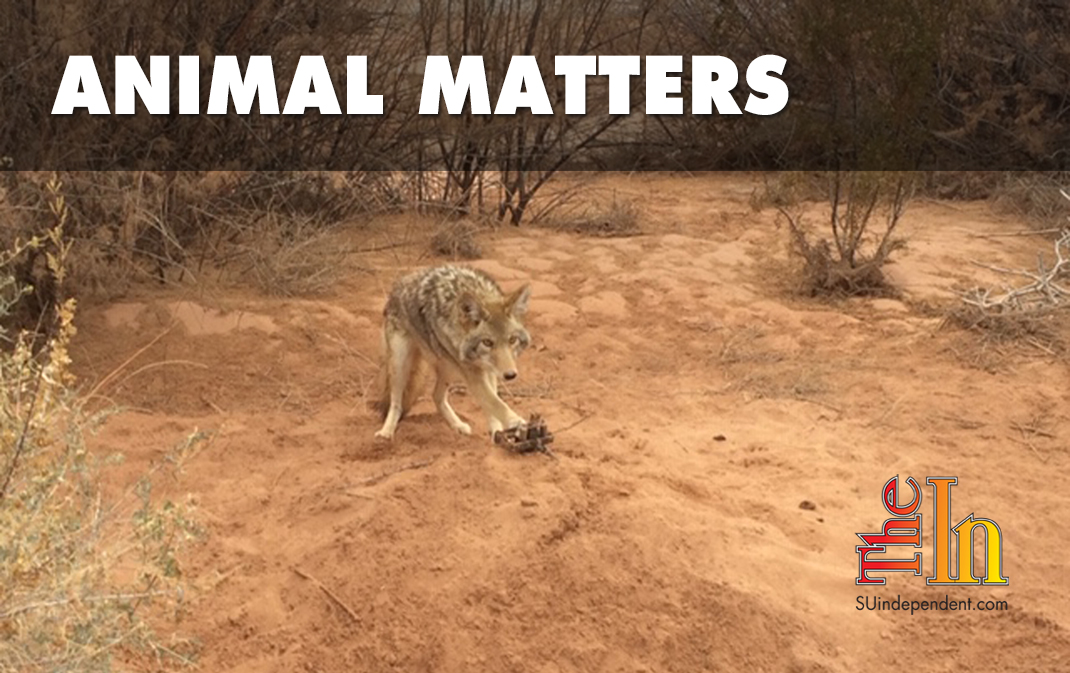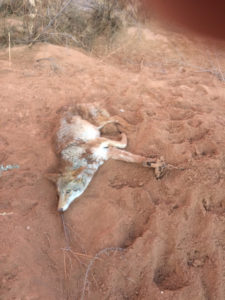
Dangerous animal trapping practices in St. George jeopardize humans and animals alike
By Kris Neal
An early morning call led to a social media firestorm, Dixie Wildlife Resources being flooded with calls and emails, a coyote being euthanized, and an investigation being opened on the legality of one particular leg restraint trap.
 Jill was running her dog by the airport in St. George when he engaged a live coyote in a leg-hold trap. Jill skillfully prevented him from being bitten by the trapped animal. Luckily, Jill was not injured in the process, but it just as easily could have gone badly.
Jill was running her dog by the airport in St. George when he engaged a live coyote in a leg-hold trap. Jill skillfully prevented him from being bitten by the trapped animal. Luckily, Jill was not injured in the process, but it just as easily could have gone badly.
Jill phoned me and asked for help with the coyote, knowing that I’ve had experience with this in the past. Confident the animal’s ultimate fate was death, my gut told me to call my husband to go put the coyote out of his misery. But my head told me that the law is the law, and I went through proper channels and asked Dixie Wildlife Resources to please send an officer out to shoot the poor animal and end its suffering.
I was told that there was nothing they could do but document the call and location and make sure the person who set the traps checks it within 48 hours. I told the officer that we just want the coyote out of its misery, not released, and that the poor thing had no food, water, or shelter. But the officer simply responded that the coyote was the property the trapper, who had 48 hours to claim his bounty.
As a civilized society, we would knowingly let the poor animal suffer for a full 48 hours in inclement weather while hoping a trapper will check his trap?
This trapper’s rights, not knowing whether the trap is legal or not, trumps the fact that Jill’s dog could have been killed by a trapped animal and that Jill could have been injured. Thus, my post on social media gathering support to get Dixie Wildlife Resources to do the right thing and euthanize the coyote. What is worse is that we knowingly allow these traps to be set where people walk their dogs, hike with their families, ride bikes, and recreate.
These traps are a public hazard. Don’t get me wrong. I am not against controlling the populations of predators. What I am opposed to is the method used.
If we must trap coyotes, humane box traps accomplish the same end goal while not endangering the public, our pets, or the animals. Twenty years of fixing the feral cats in our county has taught us that we can reduce their population by spaying or neutering them, thus taking away their ability to breed. The antiquated method of killing or moving them only increases their numbers as the cats, coyotes, or any animal will then overbreed to sustain their numbers. Immunocontraceptives would accomplish this and need to be put out there for discussion. Body hold traps had their place in another generation, but we are way beyond that now.
Even more disturbing is the sport of hunting coyotes and the way people view trapping. Pictures of youth in full camo gear holding a coyote pelt was posted to our Facebook page along with posts from people laughing about hitting the trapped coyote with baseball bats or trying to slit its throat while the animal lunged. I am ashamed that members of our community have such little regard for life. Even worse, we fund agencies that oversee such barbaric practices.
These traps are supposed to be registered with Dixie Wildlife Resources. But how many actually are, and what does that accomplish? Propaganda insists that these traps only restrain. In my experience, I’ve never run across a trap that is legal, nor have I had a trapped animal come into my care that has not lost a limb. We have seen to many incidents of people helping an animal from a trap and being injured in the process. Anybody with a driver’s license can pull into a sporting goods store and buy a $9.95 trap, pull off the side of a road, and set a trap with no regard to who could step in it.
Following reports of citizens’ pets being trapped and their owners injured freeing them, Animal Control being called to free a cat trapped just feet from a busy surgical center’s parking area, and three teens bitten by a feral cat they were attempting to free from a trap found under the River Road bridge, St. George City outlawed trapping on city property. We can rest a little easier knowing our city council is proactive. But more needs to be done to change the laws regarding trapping.
Please call Dixie Wildlife Resources at (435) 879-8694 and let them know that this is unacceptable.
Kris Neal is a longtime resident of St. George who operates One More Chance (C.A.T.S.), an animal rescue organization whose goal is to reduce the population of the feral cats in Washington County through comprehensive trapping, neutering, and return. She also has a feral cat sanctuary that is home to cats that have lost limbs to leg-hold traps.
Articles related to “Dangerous animal trapping practices in St. George jeopardize humans and animals alike”
Hamburgers and coprophagia: There’s poop in your meat, y’all



